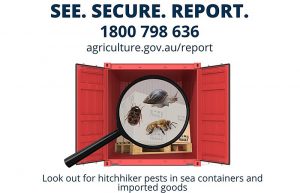
The Department of Agriculture, Fisheries and Forestry (DAFF) has launched a new campaign to keep Australia free of some of the world’s most damaging pests and address the risk of sea containers, their cargoes and associated packaging.
Australia is currently free of some of the world’s most serious pests that threaten our industries, economy, environment and way of life, thanks to our strong biosecurity system.
However, the risk of hitchhiker pests entering Australia is increasing due to climate change, intensification of agriculture, increased movement of people and products, and supply chain complexities. Pests are spreading around the world and are being found in increasing numbers on or within sea containers and imported goods.
An incursion of a hitchhiker pest in Australia could cost billions of dollars to eradicate or manage if they establish – and in the case of a sharp-shooter carrying Xylella fastidiosa, one of the biggest losers would be our industry.
The Government is therefore calling on all Australians and our international trading partners to look out for hitchhiker pests. The messages are:
Keep an eye out for anything unusual, especially when dealing with newly imported goods in Australia
Hitchhiker pests are more likely to be found in or around items that have recently arrived in Australia from overseas. This includes:
- shipping containers;
- timber pallets used to transport goods;
- cardboard boxes;
- packaging, such as loose fill packaging, plastic stretch film or sticky tape;
- recently imported break bulk cargo and large machinery, such as tractors;
- warehouses or retail stores containing imported goods;
- homes containing recently purchased goods.
Many shipping containers and imported goods are opened for the first time at ports, depots, warehouses, importer’s premises, retail stores and even personal households. It’s important to be particularly vigilant of hitchhiker pests in these settings.
What to look for
Hitchhiker pests are great at hiding, so you might only come across evidence of them, rather than the pest itself. This could be:
- sawdust and frass (insect droppings and skins);
- small holes in timber, plastic or cardboard;
- insect eggs and egg masses;
- nests such as those from ants or bees;
- snails in a variety colours, sizes and forms;
- mud smears and dirt or soil.
Of course, we need to always also keep a look out for the pests themselves.
And IF YOU FIND ANYTHING UNUSUAL, SECURE IT AND REPORT IMMEDIATELY – phone 1800 798 636 or go to http://www.agriculture.com.au/report
It’s a valuable campaign – and undoubtedly in our best interests to back it – so keep your eye out and spread the word to your networks, to make sure as many Australians as possible are on the case.
Acess more information and the link to share here.



